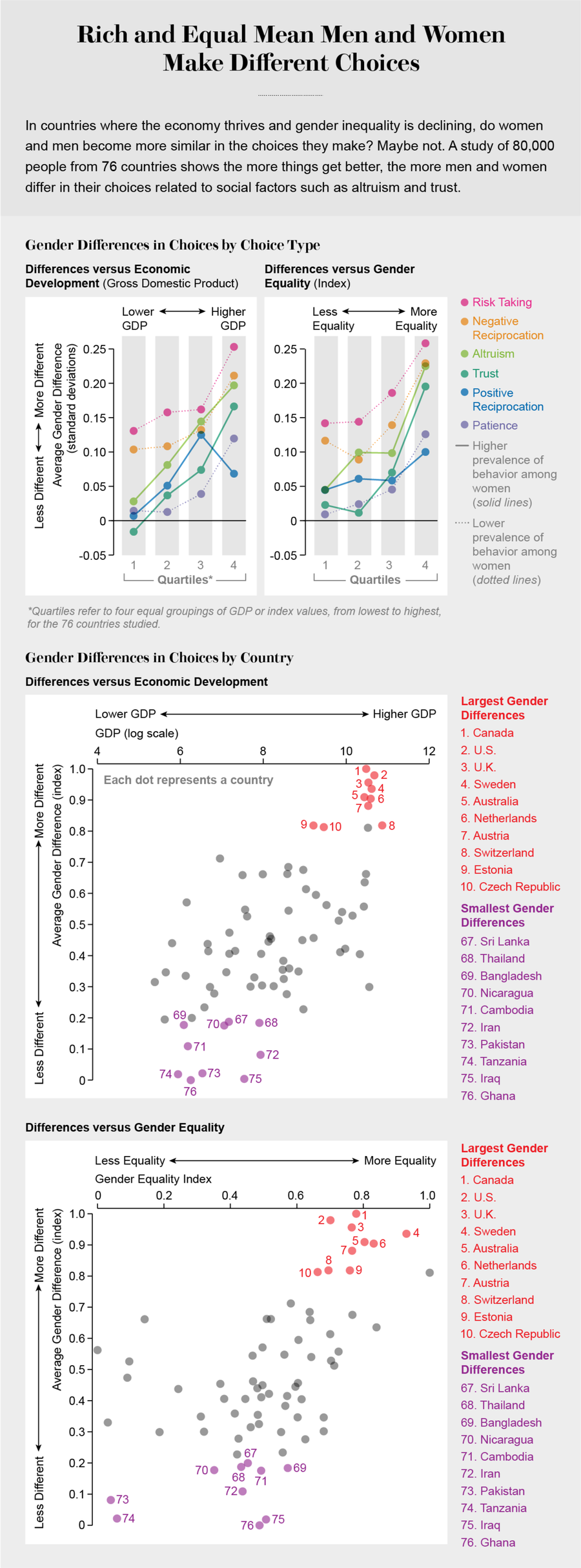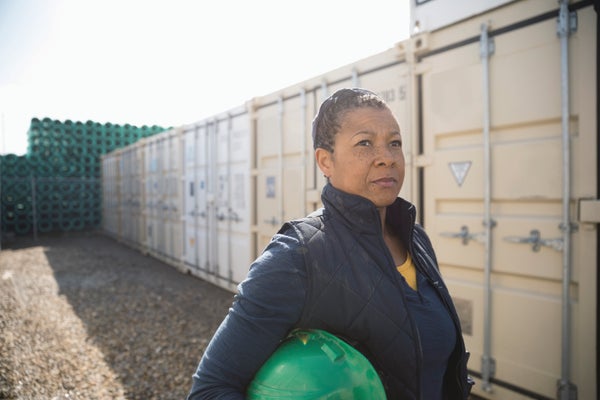In an idealized version of human existence, wealth lifts all boats, gender equality prevails and everyone behaves freely as the individuals they are.
Such a gender-equal fictional utopia starts from a premise that equal access to wealth and opportunity will erase the divide between men and women. But what if the utopian predictions are wrong? What if women and men, when all other things are largely equal, express more, not less, of a gender-based perspective?
Armin Falk, an economics professor at the University of Bonn, and Johannes Hermle, a doctoral student in economics at the University of California, Berkeley, have undertaken a massive study that looks worldwide at how national wealth and gender equality affect the choices men and women make when they think about risk taking, altruism and other social factors.
On supporting science journalism
If you're enjoying this article, consider supporting our award-winning journalism by subscribing. By purchasing a subscription you are helping to ensure the future of impactful stories about the discoveries and ideas shaping our world today.
In their study involving 76 countries and 80,000 people, they found greater national wealth and gender equality are tied to bigger differences in preferences between men and women rather than to stronger similarities [see “Rich and Equal Mean Men and Women Make Different Career Choices”]. They reported their findings, which they say favor one of two competing hypotheses on gender choices, October 2018 in Science. “This is important work that will have a lot of impact,” says Matthias Doepke, an economics professor at Northwestern University who was not involved in the study. But he says, “the world is complicated, and I think we will find that neither hypothesis alone is a good summary of the data.”

Credit: Amanda Montañez; Source: “Relationship of Gender Differences in Preferences to Economic Development and Gender Equality,” by Armin Falk and Johannes Hermle, in Science, Vol. 362; October 19, 2018
Those hypotheses address how national wealth and equality affect the choices men and women make. One of them, which the authors dub the “social role hypothesis,” predicts wealth and gender equality will lead to more similarities in preferences between genders. With equality and readily available resources, the idea goes, women and men will become more alike in their ways.
The “resource hypothesis,” in contrast, holds that abundance and equality will give men and women more freedom to express gender-related preferences, unconstrained by hardships that might force them to do otherwise. In this scenario a woman who worked in male-dominated field 50 years ago might have felt pressured to behave as “one of the boys.” But with a more equal gender representation in the workplace, perhaps such constraints would fade, leaving her freer to express more gendered preferences if she wishes.
To test these two hypotheses, Falk and Hermle used responses to a survey from people representing every continent and countries at every level of economic development. The Global Preferences Survey asked participants about how they would respond in different scenarios involving six social factors: risk taking, patience, altruism, trust, and positive and negative reciprocation (responding in kind to positive or negative interactions). For example, for positive reciprocity respondents had to settle on how much they would pay for a thank-you gift to a total stranger in return for a kind deed. They also rated their responses to the statement, “When someone does me a favor I am willing to return it.” They were asked to rate their responses on a 0 to 10 scale, with 0 being not at all willing.
When the two researchers aligned these responses with the gross domestic product (GDP) for each country, they found higher GDP tracked with increasing differences in men and women’s preferences. When they mapped the survey responses against an index of gender equality in each country—based on factors such as when women gained the right to vote—they found again greater equality tracked with an increasing gender gap in preferences around trust, altruism and the other variables.
Falk and Hermle also batched GDP values into four groups to assess each of the six social factors separately. For all six, the two genders were much more similar in their preferences in the lowest compared with the highest GDP groups. The same pattern applied for gender equality: Across four bins of gender-equality index values the lowest values were associated with the smallest gender differences, the highest with the greatest gender differences in preferences. “Our study confirms the (resource) hypothesis,” Hermle says. “The main takeaway is that gender differences in preferences are increasing with country level of economic development as well as gender equality.”
Alessandra Fogli, monetary advisor in the research department at the Federal Reserve Bank of Minneapolis who was not part of the study, sees a missed opportunity in the analysis. “I wish they had first discussed the variation of overall preferences across countries, such as how trust or risk aversion vary across income groups, and not just the differences across genders,” she says. “The paper offers a suggestive, interesting finding to motivate a deeper, more systematic analysis. But I do not find it conclusive.”
Doepke also expresses some uncertainty. “I think the contrast and evaluation of the social role and resource hypotheses is a bit too simplified,” he says. “What should matter is conditions when the respondents of the study were socialized.” He points out that with survey participants ranging in age from adolescence to the 90s, socialization could have occurred decades ago for some, when gender divisions even in the richest economies “were very sharp.” He adds, “gender-preference gaps among millennials would tell us something about how boys and girls were socialized in the last 25 years or so whereas preference gaps for older cohorts would be informative on conditions in earlier times.” Having more resources, he notes, might simply mean parents have more time to socialize their children in gender-specific ways.
According to Hermle, various explanations for the findings are plausible. These social roles “are very powerful in explaining gender differences and preferences,” he says, but the current study did not measure such factors. Their findings establish a pattern that needs to be further examined to confirm or reject underlying causes, he notes.
Hermle also wants to ensure their findings are not misinterpreted as favoring evolutionary or biological explanations over social factors. “The biggest misinterpretation could be that our results indicate that social or gender-specific roles do not matter in the formation of gender differences in preferences,” he says. “I do think that they matter a lot.”
